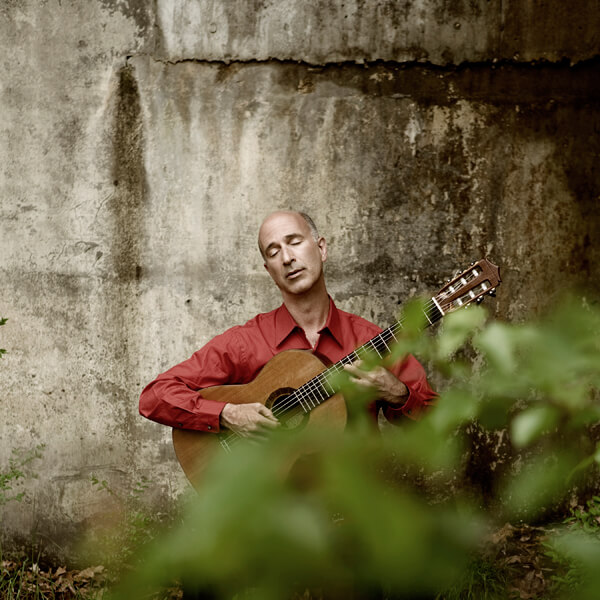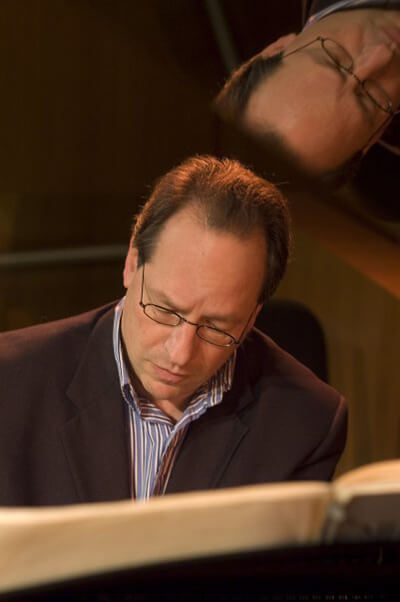 Classical guitar is a pain in the ass. The way you’re meant to sit: weird/humiliating. The disparity between left and right hand technique: completely frustrating. Reading guitar music at sight: laughably annoying. And, perhaps most maddening: trying to project to a point at which an audience can actually hear you once you get all those other things to jibe. Maybe these reasons are why the instrument is so often neglected in the realm of chamber music, and furthermore, maybe that’s why there’s such a preciously tiny handful of classical guitarists that have broken the boundary into composition and true musicianship – because so few of us have the facility to deal with our own instrument, let alone communicate with or through other ones. That is why seeing David Leisner perform alongside pianist and compadre Jon Klibonoff as part of Symphony Space’s Guitar Plus series marked, for me, a kind of breakthrough. Apart from Leisner’s amazing facility that showed the guitar can definitely hang with arguably the most important instrument in the history of western music, his original composition for piano solo proved that classical guitarists can be legitimate musical thinkers with the ability to range out of the cramped knot that is them and their instrument and into a world of sound and color that points towards totally new directions.
Classical guitar is a pain in the ass. The way you’re meant to sit: weird/humiliating. The disparity between left and right hand technique: completely frustrating. Reading guitar music at sight: laughably annoying. And, perhaps most maddening: trying to project to a point at which an audience can actually hear you once you get all those other things to jibe. Maybe these reasons are why the instrument is so often neglected in the realm of chamber music, and furthermore, maybe that’s why there’s such a preciously tiny handful of classical guitarists that have broken the boundary into composition and true musicianship – because so few of us have the facility to deal with our own instrument, let alone communicate with or through other ones. That is why seeing David Leisner perform alongside pianist and compadre Jon Klibonoff as part of Symphony Space’s Guitar Plus series marked, for me, a kind of breakthrough. Apart from Leisner’s amazing facility that showed the guitar can definitely hang with arguably the most important instrument in the history of western music, his original composition for piano solo proved that classical guitarists can be legitimate musical thinkers with the ability to range out of the cramped knot that is them and their instrument and into a world of sound and color that points towards totally new directions.

On the evening of March 29, Leisner and Klibonoff joined each other onstage before an unfortunately sparse crowd of chatty listeners. The presence of the performers, however, diffused any ill feelings in the hall, their friendship, communication, and, yes, Mr. Leisner’s purple velvet pants all radiating the graceful confidence that one might expect when seeing world class musicians tackle serious chamber music. Leisner and Klibonoff have known each other for some twenty years, and both have cultivated incredibly impressive careers and accolades. Their friendship and musical prowess would suggest that collaboration between the two would be a given, however Leisner himself freely admitted that guitar and piano makes for “such a weird combo.” Klibonoff also confessed that the duo had specific set of difficult challenges to overcome in the way that the similarities between the two instruments’ attack and decay had them stepping all over each other in rehearsal.
Hans Haug’s Fantasia was the first piece on the bill that really displayed the merits of a guitar and piano duo. Haug was a rare composer who was a dedicated fan of the guitar and did his part to expand a needy repertoire. His largely forgotten Fantasia, written in 1957, made for a perfect setting of Leisner and Klibonoff’s collaboration in that it is a piece comprised of possibilities. Leisner and Klibonoff’s performance was marked by an enthusiasm that pushed their instruments to their furthest reaches while—to the credit of the performers—retaining a precise balance. The similarities in attack and decay that Klibonoff referenced were on display in a way that suggested that one instrument was an extension of the other, notes living and dying with a reciprocally beautiful vivacity. The performers worked together to further this emphasis, Leisner’s piano pushed to forte and vice versa for Klibonoff. In the vacuum of Fantasia it completely worked, and Klibonoff’s ability to play with abandon while still remaining sensitive to his partner’s dynamic limitations was exciting to behold. Leisner on the other hand relished in Haug’s familiarity with the guitar, playing music that featured some of the strummy, riffy, pentatonic segments that exude flash but are intuitive to guitarists.

The premiere of Australian composer Peter Schulthorpe’s Oh, T.I.! proved that there are still people out there considering the possibilities of meetings between guitar and piano, however, the most fascinating piece of the evening was performed sans Leisner, or, sans Leisner’s guitar. Labyrinths No. 2, written by Leisner and also receiving its premiere at the concert, is a solo piano piece in four movements that are each inspired by musical gestures by J.S. Bach, Leisner’s fixation on whom is unsurprising. Arrangements of Bach’s music serve as a legitimizing cornerstone of the classical guitar rep, and Labyrinths No. 2 can be put on the list of avant garde pieces inspired by that old master of polyphony, a list that includes works by the likes of Berg, Hindemith, and Uri Caine. Bounce, the first movement, was based on a typical Bachian gigue gesture. Into the dark, the second movement, took the very first measure from the very first prelude of The Well-Tempered Clavier and slowly morphed into something completely new, Klibonoff’s right hand inching upwards while the left descended further and further (something akin to a work by Conlon Nancarrow but that featured shifting accents only a flesh and blood human could truly communicate). The last movement, in memory, quoted the final chorus of the St. Matthew Passion, a familiar tune to guitarists in that Bach used it for the sarabande of his 2nd lute suite. Leisner’s fascination with mimicking the feel of naturally shifting patterns over extended periods of time was totally appropriate in this context, considering that the music of Bach, for all its perfection, features an inherently organic, lush quality from which seemingly infinite amounts of new sounds can blossom. In the hands of Klibonoff Labyrinths No. 2 was a rousing success, his playing capturing the exactitude required for a Bach recital as well as the instinctive, improvisatory gesticulations prescribed by the hand of Leisner.
To hear the imagination of a guitarist gallivanting around on the keyboard, tickling the work of one of its greatest masters, was ultimately the most refreshing part of the entire night, and made for the kind of moment that I believe could help inspire and emancipate any musician who feels like they might be stuck behind their own instrument. So, kudos Mr. Leisner – you made the world of classical guitar a better, more complete place, this time without even having played a note.
For more information about David Leisner, visit: http://www.davidleisner.com | Discover David Leisner’s latest album, Favorites, on Amazon.
—
Elias Blumm is a classical guitarist in New York City. Find him on Twitter: @theEelz
























